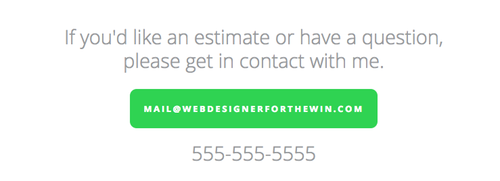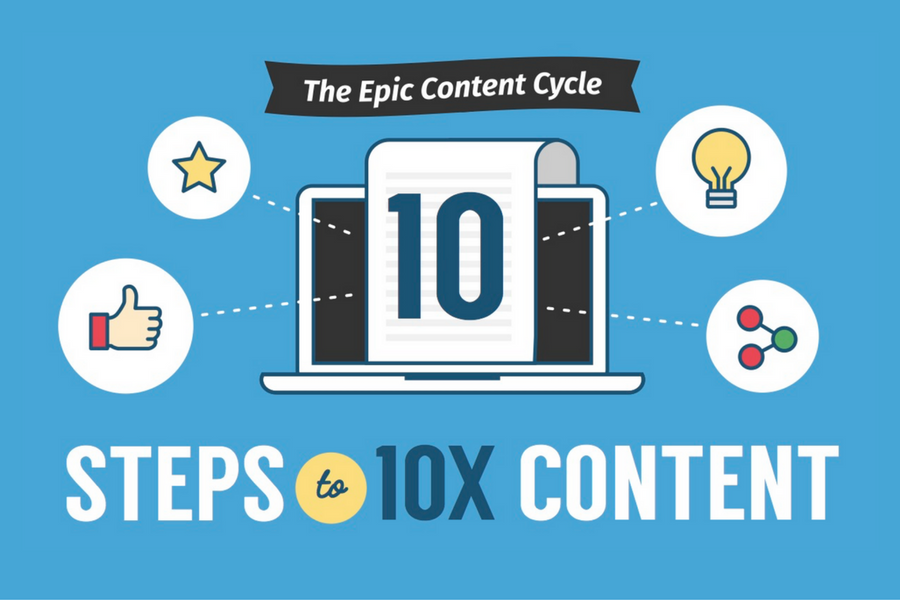
Strange feeling, isn’t it?
Both exciting and terrifying at the same time.
But that’s what it’s like, starting an online business.
On the one hand, you know you were meant to do more with your life than being stuck in a job you hate.
On the other, starting a new business is risky — and the thought of failing and crawling to your boss to beg for your old job back paralyzes you with fear.
You yearn to take control of your destiny and see where your passion leads you. But passion is not enough, and you know it. To make it work, you need to create a source of self-sustaining income.
For most people, though, starting a business doesn’t sound like fun. At least not compared to “following your dream.”
But if you really want to gain your freedom while making your mark on the world, you have to make the leap. You have to start your online business.
And honestly, you couldn’t have picked a better time to do it. The Online Revolution is here and in full swing, ready to scoop courageous entrepreneurs into its warm, multi-billion-dollar embrace.
And that’s frickin’ exhilarating!
But the possibility of embarrassing, crippling failure is still very real.
So what’s a would-be online entrepreneur to do?
If You’re Not Scared Witless, You’re Probably Being Reckless
Let’s be honest, the insane number of moving parts required for a successful online business are intimidating enough to make even the most determined entrepreneur freeze like a deer in the headlights.
Getting started feels like jumping on a merry-go-round that’s spinning 1,000 miles per hour.
And that’s when the reality of failure sneaks in and threatens to smack that revolutionary opportunity right out of your hands.
But wait…
What about “taking action,” “failing fast” and “pivoting?” Aren’t they the true path to entrepreneurial success?
Well… kinda.
Because there’s a huge difference between failing while doing something the right way, and failing because you jumped in unprepared for the challenges ahead.
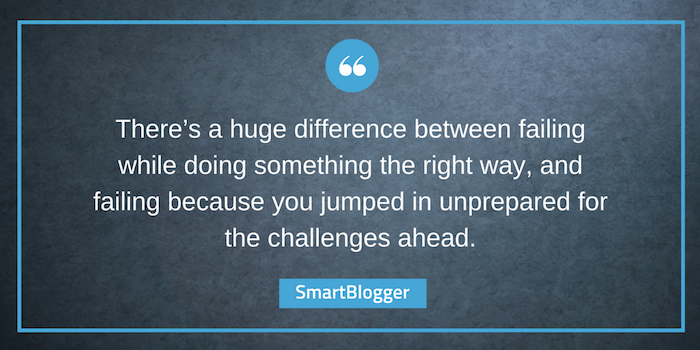
Now, I know what you’re thinking. Nobody can be 100% prepared for an uncertain journey like entrepreneurship. And you’re right.
But ironically, it’s our fear of failure that drives us to make some pretty silly mistakes.
In a mad dash to take action, make progress, and draw ourselves closer to the finish line, we forget, overlook, or flat-out ignore vital steps in the business building process.
Well, the good news is that many of the most common reasons why online businesses fail are completely avoidable — if you know what they are.
But here are five things to do if you’re still hell-bent on failure (and some practical advice for dodging each bullet just in case you aren’t):
#1 Create a Horrific Franken-Strategy
It seems like someone launches a new tactic, strategy or business model every week — if not every day.
The outcomes they promise are so tempting that it’s damn near impossible to resist trying them.
I mean, how can you turn your back on strategies that offer to “10x” your content, traffic, profits, and email list?
Here are just a few of the tantalizing offers that could drop into your inbox any week of the year:
- Get 100,000 Instagram Followers
- Get 10,000 email subs with Facebook ads
- Build a 6-figure online course
- Become a popular guest blogger
It never ends…
So you get scatterbrained and decide to try a little bit of everything. You take bits and pieces of powerful strategies and tactics from multiple mentors and coaches and blindly mix them together.
But in doing so, you inadvertently create a monster. A monster that’s destined to wreak havoc and destroy your business, your time, and your pocketbook.
I like to call this monster a Franken-Strategy.
Here are some examples of what this powerful beast looks like:
- As you work on growing your email list with guest blogging, you decide to take a shortcut and mix in a couple of quick Facebook ads. And for good measure, you add a few Instagram marketing tactics.
- As you work on building your blog traffic, you decide to try a little bit of everything: social media, random list building hacks, and what the heck… toss in some SEO stuff too.
- As you work on getting your online coaching business off the ground, you decide to tinker with Pinterest marketing, and perhaps a webinar or two. While you’re at it, you stitch a few surveys to that bad boy.
The sneaky part about these crazy combos is you see popular online business gurus mixing it up all the time. And it seems to work great for them — after all, they’re gazillionaires.
Well, here are two problems with that:
- An effective strategy is put together a certain way for a reason. You usually can’t omit or change key steps without breaking it. (Otherwise, it wouldn’t be a strategy, just a collection of ideas.)
- You know those experts you follow? Yeah, they’re pros at this strategy mixing stuff. They probably tried it the “pure” way initially, tweaking it based on their results to make it work even better for them.
Sure, you’re a pro at being a life coach, nutritionist, writer or something else, but those passion-based skills differ considerably compared to those required to run and market a business.
So resist the temptation to pick and choose your tactics like you just reached the front of the queue at an all-you-can-eat buffet.
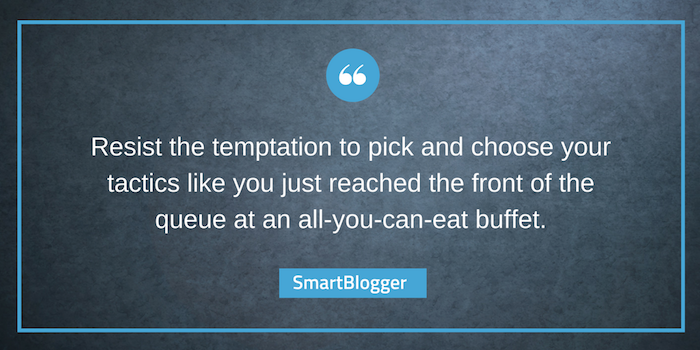
Now at this stage, you might think:
Hey, it’s my business. I can do whatever I want!
And you’re right.
But what if doing whatever you want with your strategy stops you from getting what you actually want from your business?
I know it’s not easy to hear. But it’s true.
So pick a mentor with a strategy that feels doable for you — and stick to it. Give that one strategy a chance to shine on its own.
#2 Insist on Doing Every Damn Thing Yourself
We’ve all been there. Your car needs servicing, so you decide to train as an auto mechanic and do the work yourself.
Except, of course, you don’t.
But that’s the approach many people take to key tasks in their online businesses.
When our business requires a specialist’s skill, we’ll happily spend hundreds of hours immersed in “how to” posts — or thousands of dollars on books and courses.
But if I’ve learned anything from my four failed online businesses it’s this:
You can’t do it all and expect to keep your head above water.
Tackling every aspect of your business all by yourself simply will not work.
Now, what about you? Do you recognize any of these business-crushing mistakes:
- You bury yourself in tutorials and knowledge bases for months so you can customize a complicated WordPress plugin or theme instead of using a more user-friendly theme that works right out of the box.
- You need some compelling copy for your website so you decide to spend $2K on a 3-month master copywriting course instead of hiring a copywriter who can complete it in a week for half the cost (or less).
- You want better Google rankings, so you bust your brain trying to apply complicated SEO tactics to your blog posts instead of hiring an agency to do it for you.
- You waste time trying to personally handle administrative tasks like basic customer support emails instead of hiring a VA to assist you.
The list goes on and on…
Here Are 3 Common Reasons You Try to Do Everything Yourself:
1) Control
You not only want it done the right way, but you also want it done your way. You believe depending on someone else to help you only adds more risk to the equation.
However, having the ability to attend to every single task for your business is not only an illusion; it’s impossible. There simply isn’t enough time or energy to play a significant role in every aspect of your business.
At some point, every successful entrepreneur has to let go of some of the reins and delegate responsibilities to others. If you can’t, you’ll never scale your business.
2) Budget
Whether you truly lack the funds or you’re just a tightwad, the money isn’t there, and you can’t afford to pay anyone else to do the work for you.
It might be tough to accept, but most online businesses need an upfront investment, which means you may not be financially ready to start one yet.
However, if you have a small budget, you can stretch it by compromising on certain things. For example: be satisfied with an out-of-the-box theme with no customizations, use a wordmark instead of a designed logo, and use free software and plugins.
3) Procrastination
It’s only natural to protect yourself from failure by attempting to prepare yourself for success. You don’t want to look like a fool, right? So you tell yourself that you need to learn this “one last thing… and then you’ll be ready to launch.
However, there’s no such thing as the right time to start. And delaying will not lessen any of the exposure or life changes that are holding you back.
Even though it’s scary as hell, you’ll likely discover that once you jump in, getting started and being exposed isn’t as bad as it seems.
Look, I Get It…
In the beginning, it may seem as though a new entrepreneur has to wear all the hats. But remember, you’re only one person, and you can’t assume the roles of CEO, marketing manager, content creator and customer service provider if you want to succeed.
Because if you think it’s tough to do everything in the beginning, it only gets worse as your business starts to take off.
So the next time you’re tempted to enroll in a $2,000 course or spend months learning a new skill or marketing technique, ask yourself if you could more wisely spend your time and money delegating tasks or making compromises while continuing to grow your business.
#3 Make It All About You (Even Though You Know You Shouldn’t)
Quick question: Who should be the focus of your blog and online business: you, or your audience?
Your likely response: “My audience. Duh!!”
“Is this a joke? Am I being punked?”
I mean, every smart blogger knows this. It’s Blogging 101, right?
The funny thing is, when the time comes to develop and execute their business’s content and design, I have yet to find a single freelancer or entrepreneur who doesn’t buck against this advice. They always let their personal preferences and hunches take center stage.
Even stranger: when I confront them, attempting to educate and warn them of the perils, they admit that many of their choices cater more to themselves than their audience, brand, conversions or their business.
It’s like warning someone that a hot stove will burn them, and their response is “Oh I know that, but I’m gonna touch it anyway. Thanks!”
My point?
You know your business should focus unwaveringly on your audience. You hear it all the time.
You get it. But you don’t practice it.
So why is that?
Well, building your business to cater to other people is a painful and counter-intuitive process. After all, it’s your business, and you want it to represent you and your knowledge.
You want to look at your site and see a reflection of yourself. Something friends and family will say “Oh, that’s totally you.”
The problem is — none of that matters.
What does matter is what your audience expects to see. And even more importantly, that your audience sees a reflection of themselves — not you.
The first step is to stop thinking of your online business as a personal project. It’s not a scrapbooking session. And it’s not a mysterious bottom-of-the-pantry casserole either.
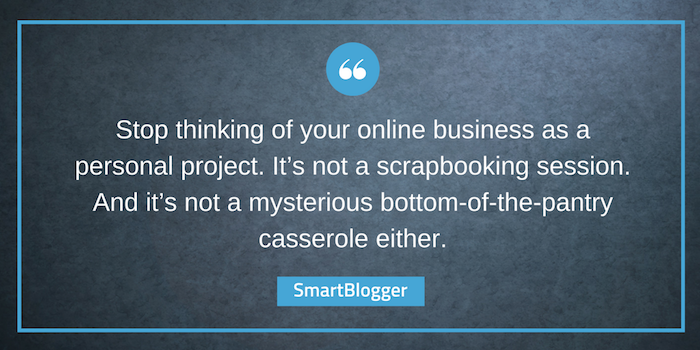
Instead, think of it for what it is:
It’s a business designed for a specific audience.
Here’s a case in point:
A food blogger creates a site that looks like a food blog. And even though she doesn’t like how most food blogs look, she goes with it because it works… it’s what her audience expects to see. And she also has content and recipes that her audience craves. Not just a collection of what she likes (or even worse — what she thinks her audience should like).
There’s a reason why Mexican restaurants look like Mexican restaurants and serve Mexican food. There’s a reason why social media sites look like social media sites and offer social interaction tools. There’s a reason why minimalist blogs look minimal and offer minimalist content.
And that reason is: that’s what the audience expects and wants.
Don’t get me wrong. I strongly encourage you to apply your own personal twist in your writing and design. But if you twist too far, so much so that your audience can’t recognize their expectations in your offer, you’ll break your business for sure.
If you’re struggling with design, pick a proven template or hire a designer with a track record in your niche. Not sure which of several options works best? Ask your audience. It doesn’t matter which you prefer. (But try telling your ego that.)
As for content, you already know the answer:
- Do your research (e.g., blog comments, forums, social media).
- Pick topics your audience craves (not just ones you find interesting).
- Engage with your readers and use their feedback to refine your focus.
Always keep your sights on your audience and don’t let those self-centered choices get in the way.
Because you must wrap your head around this:
Your audience doesn’t care about you. They only care what you can do for them.
Fail to make that connection, and you’ll fail to deliver what they want.
And that means your business will fail.
Every time.
#4 Try to Be a Second-Rate Someone Else
You’re smart. You know that the quickest way to building an online business is to tap into the wealth spring of a profitable market that already exists.
And let’s face it, the best sign of a healthy market is that other businesses are already thriving there.
In fact, some of those businesses are probably your role models — influential bloggers with hordes of raving fans and an enviable online empire full of million-dollar products.
Talk about a proven market!
But while it’s only natural to aspire to a similar level of success, there’s a real danger in copying your role models too closely. You’ll end up creating a “me too” business, one that fails to differentiate itself from the others already established in the market.
Let’s say you’re a huge fan of Jon Morrow. So you decide to target the same audience as Jon. You try to write headlines like Jon. You do your best to tell stories like Jon. You even imagine creating products like Jon.
But the thing is, you’re not Jon. Try as you might, you’ll always be a pale imitation.
So you have to ask yourself: why would readers who resonate with Jon’s content and style read your blog instead of — or even as well as — his?
In other words, why would anyone choose the imitation when they can have the original?
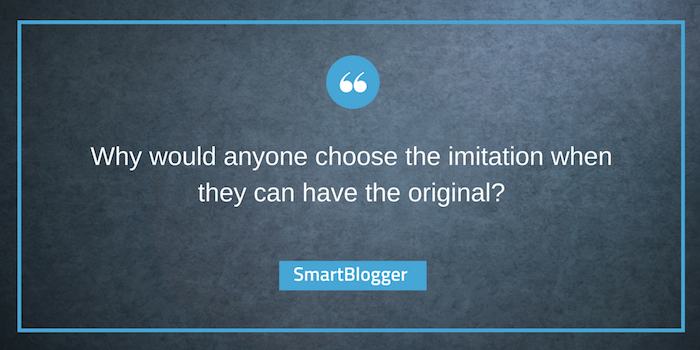
Of course, that’s not to say you couldn’t build a blog as popular as Jon’s, but you’ll never be able to out-Jon, Jon. So if you want to appeal to the same audience, you need to do it in a different way.
But let’s say you want to appeal to an entirely different audience. Let’s say you want to be the Jon Morrow of technology, parenting or even… interior design?
Well then, my friend, you could be onto something. Because then you have a differentiator. You’re bringing a distinctive blogging and online business style into a niche where it doesn’t exist yet.
(Just better hope Jon doesn’t start blogging on those topics!)
So never forget that you need a strong differentiator. Something about you, your business or your product that sets you apart.
In other words, you need a strong answer to the question:
“Why would people read my blog and buy my product or service instead of the already established alternatives?”
But how can you do that?
The possibilities are numerous, however, here are few ways to stand out in a sea of sameness:
- Have a strong attitude. Take a stand for your worldview… and don’t ever back down. You don’t have to name names and call people out. Rather, you can pick a fight with the status quo. Be bold. Be daring. Yell it from the rooftops!
- Pick a different format. If your role models tend to publish long-form blog posts, then try publishing in a video or audio format. If your niche is already swamped with good content, become a curator instead of a creator (just as Brian Clark did with his Further newsletter).
- Revitalize a classic. Find a tired method, strategy or mindset that still works and give it a useful upgrade. Seth Godin did this with his book Purple Cow. He took the classic teaching of developing a unique selling proposition (USP) and gave it a modern-day upgrade. What if you applied minimalism to parenting? Or the 80/20 rule to career development?
Next time you’re tempted to follow your heroes too closely, just ask yourself what kind of entrepreneur you want to be: a passable forgery or a true artist?
#5 Refuse to Make Real Sacrifices
You see it on every online course sales page, launch email, and money-back guarantee. Like the big list of side-effects at the end of a drug commercial, it’s always there. You can’t miss it.
“You gotta put in the work. If you aren’t willing to put forth an honest effort, then this course is not for you.”
It’s become such a common statement that you tend to blaze right past it while thinking “Yeah, Yeah, I get it. I’ll do the work. Now where’s the damn buy button?”
But here’s the thing…
Nobody tells you what “putting in the work” actually means.
Well I’m going to expose that sneaky little phrase for what it really means:
You must be willing to make sacrifices.
Building a business takes time, money, and energy. If you’re serious, then something must give. Extra time doesn’t just magically appear the moment you hand over your PayPal details.
No successful business owner got where she is without making numerous sacrifices in exchange (at least at first).
Here are the kinds of sacrifices I’m talking about:
- Watching less TV (and that includes the latest must-see Netflix series)
- Giving up on some of your hobbies
- Working in the evenings & on the weekends (even if you don’t feel like it)
- Declining invites from family and friends (and maybe getting into trouble for it)
- Being less dedicated to your day job (which could affect your offline career)
Look, your sacrifices don’t have to be sudden and brutal — they can be methodical and gradual.
I’m not asking you to abandon your family, destroy your career, reject all forms of enjoyment, and become a maniacal, business-obsessed hermit.
However, you must take a long, hard look at what you do with your time. And figure out how you’re going to make room for your business.
Some people find it helpful to write down daily routines over the course of a week. Be honest and specific. Make a list of everything you spend time doing, as well as how much time it takes. Then go through your time inventory and make as many cuts and adjustments as you need.
For each item ask: is this more important than getting my online business off the ground? If not, consider cutting it.
Others find it easier to make sacrifices on the fly. They decide from week to week as their business commitments fluctuate.
And a few brave souls take huge plunges like quitting their day jobs. That way they’re forced to make their business a top priority. It’s a high-risk strategy but for certain people the lack of a safety net is the best motivator they know.
I can’t tell you exactly what to sacrifice. It’s up to you to decide what to cut and how much.
But I can tell you that without sacrifices, without shifting your priorities, you’ll never create the business of your dreams.
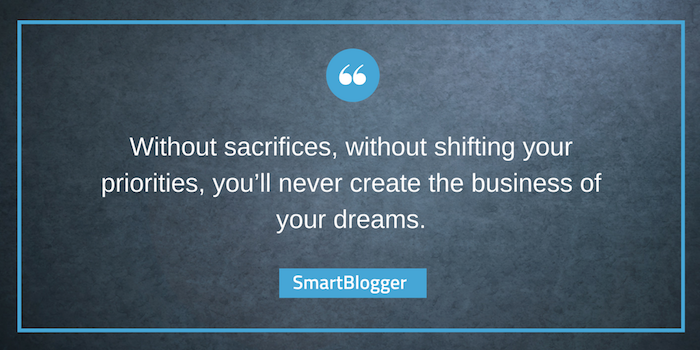
Stop Inviting Failure and Get on the Path to Success
Starting an online business is risky, no doubt about it.
And going into something feeling like the deck is already stacked against you is discouraging, even downright depressing.
But not all risks are created equal. In practice, you can slash the chances of your business flopping by opening your eyes to how and where failure most often occurs.
So study the lessons above and make sure you’re not cruising towards failure along one of these misguided paths.
Will this insure you completely from defeat? Of course not.
But armed with a knowledge of the most common pitfalls, I have a feeling you’re not going to let that stop you.
Because even though you know that the road to online success is paved with a million failed dreams, there’s something special about us entrepreneurs.
Despite improbable odds, immeasurable fear, and the toughest of sacrifices, we refuse to be defeated.
And that’s the secret to it all:
When you’ve eliminated the risks you can control, you must dive in and start clearing a path to success. And if you hit a road bump or make a mistake, brush yourself off, learn something useful from it… and then pick your ass back up for another round.
Because that’s what real entrepreneurs do.
So, are you ready to make that leap?
